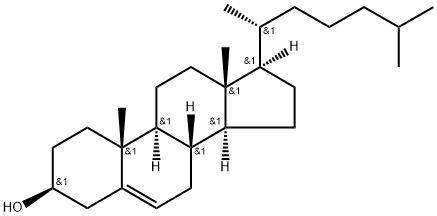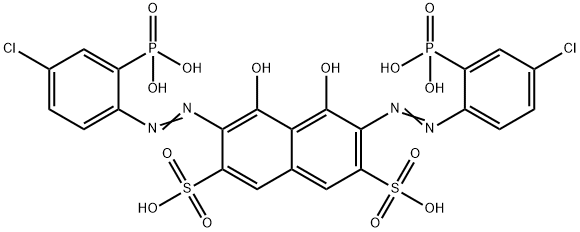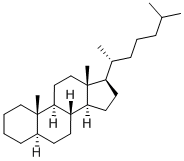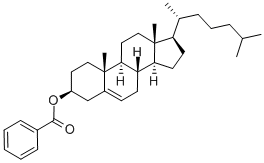Cholesterol , 99% , 57-88-5
Synonym(s):
Cholesterol;Cholesterol from wool fat;Cholesterol, Highly Purified - CAS 57-88-5 - Calbiochem;Cholesterolum;Synthetic cholesterol
CAS NO.:57-88-5
Empirical Formula: C27H46O
Molecular Weight: 386.66
MDL number: MFCD00003646
EINECS: 200-353-2
| Pack Size | Price | Stock | Quantity |
| 1G | RMB26.40 | In Stock |
|
| 100G | RMB423.20 | In Stock |
|
| 5G | RMB623.20 | In Stock |
|
| 25G | RMB1439.20 | In Stock |
|
| others | Enquire |
PRODUCT Properties
| Melting point: | 148-150 °C |
| alpha | -36 º (c=2, dioxane) |
| Boiling point: | 360 °C |
| Density | 1.06 |
| refractive index | 1.5250 (estimate) |
| Flash point: | 250 °C |
| storage temp. | -20°C |
| solubility | H2O: 0.002 mg/mL |
| pka | 15.03±0.70(Predicted) |
| form | powder |
| color | white |
| Specific Gravity | 1.067 |
| Odor | wh. or faintly yel. pearly granules or crystals, almost odorless |
| biological source | synthetic |
| Water Solubility | negligible |
| Merck | 14,2201 |
| BRN | 1915888 |
| Dielectric constant | 2.9(Ambient) |
| InChIKey | HVYWMOMLDIMFJA-DPAQBDIFSA-N |
| LogP | 9.619 (est) |
| CAS DataBase Reference | 57-88-5(CAS DataBase Reference) |
| IARC | 3 (Vol. 31, Sup 7) 1987 |
| NIST Chemistry Reference | Cholesterol(57-88-5) |
| EPA Substance Registry System | Cholesterol (57-88-5) |
Description and Uses
Cholesterol is a soft waxy substance that is a steroidal alcohol or sterol. It is the most abundant
steroid in the human body and is a component of every cell. Cholesterol is essential to life
and most animals and many plants contain this compound. Cholesterol biosynthesis occurs
primarily in the liver, but it may be produced in other organs. A number of other substances
are synthesized from cholesterol including vitamin D, steroid hormones (including the sex
hormones), and bile salts. Cholesterol resides mainly in cell membranes.
Humans produce about 1 gram of cholesterol daily in the liver. Dietary cholesterol is consumed
through food. High cholesterol foods are associated with saturated fats and trans-fatty
acids (commonly called trans fats). Dietary cholesterol comes from animal products (plants
contain minute amounts of cholesterol) such as meats and dairy products.
Cholesterol be used as pharmaceutical intermediates and be used as synthetic materials of liquid crystal polymers.
Safety
| Symbol(GHS) |   GHS06,GHS08 |
| Signal word | Danger |
| Hazard statements | H302-H315-H319-H331-H336-H351-H361d-H372 |
| Precautionary statements | P201-P261-P304+P340+P312-P305+P351+P338-P308+P313-P403+P233 |
| Hazard Codes | Xn,Xi |
| Risk Statements | 10-48/20/22-40-38-22-36/37/38-67-36/38-20-63 |
| Safety Statements | 24/25-22-36/37-36-26 |
| RIDADR | UN 1170 3/PG 3 |
| WGK Germany | 1 |
| RTECS | FZ8400000 |
| TSCA | Yes |
| HS Code | 2906 13 10 |
| HazardClass | IRRITANT |
| Hazardous Substances Data | 57-88-5(Hazardous Substances Data) |
| Toxicity | Present in all parts of the animal body; concentrated in spinal cord, brain, skin secretions, and gallstones. An unsaturated, unsaponifiable alcohol (m.p. 149℃). It is synthesized in the body from ethanoate units; its metabolism is regulated by a specific set of enzymes. It is the parent compound of many other steroids and its presence in high concentrations in the blood is suspected as being a contributory factor in cardiovascular disease. |





